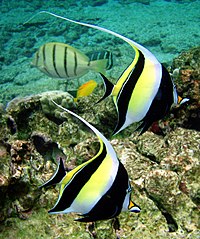Moorish idol
| Moorish idol | |
|---|---|
 |
|
| Scientific classification | |
| Kingdom: | Animalia |
| Phylum: | Chordata |
| Class: | Actinopterygii |
| Order: | Perciformes |
| Family: | Zanclidae |
| Genus: |
Zanclus Cuvier in Cuvier and Valenciennes, 1831 |
| Species: | Z. cornutus |
| Binomial name | |
|
Zanclus cornutus (Linnaeus, 1758) |
|
The Moorish idol (Zanclus cornutus), is a marine fish species, the sole extant representative of the family Zanclidae (from the Greek ζαγκίος, zagkios, "oblique") in order Perciformes. A common inhabitant of tropical to subtropical reefs and lagoons, the Moorish idol is notable for its wide distribution throughout the Indo-Pacific. A number of butterflyfishes (genus Heniochus) closely resemble the Moorish idol. It is closely related to, if not a direct descendant of, the extinct Eozanclus brevirostris, from the Middle Eocene of Monte Bolca.
The Moorish idol got its name from the Moors of Africa, who purportedly believed the fish to be a bringer of happiness. Moorish idols are also a coveted aquarium fish but, despite their abundance and wide array of habitats, they are notoriously finicky and hard to adjust to captivity. Their omnivorous diet can be extremely difficult to replicate in aquaria, as the vegetation which they live on is normally exterminated and they unfortunately have a habit of snacking on corals and sponges which are extremely expensive.
With distinctively compressed and disk-like bodies, Moorish idols stand out in contrasting bands of black, white, and yellow, which makes them attractive to aquarium keepers. The fish have relatively small fins, except for the dorsal fin, whose six or seven spines are dramatically elongated to form a trailing, sickle-shaped crest called the philomantis extension. Moorish idols have small terminal mouths at the end of long, tubular snouts; many long bristle-like teeth line the mouth. The Moorish idol differs from butterflyfish in having a prominent black, triangular anal fin.
...
Wikipedia

